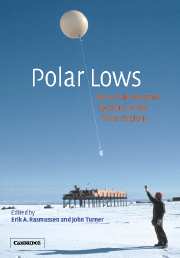3 - Observational studies
Published online by Cambridge University Press: 07 December 2009
Summary
The Arctic
Introduction
For several decades observational investigations in the form of case studies have supplied an important part of the attempts to understand the structure and development of mesoscale vortices. Apart from obtaining a description of the individual cases, an underlying purpose has been, through a synthesis of the different cases, to gain sufficient knowledge to describe the basic properties of these systems, including their structure and dynamics. Present-day high resolution numerical models have proved to be very effective for simulating the structure and development of mesoscale systems, such as polar lows in data sparse regions, and case studies in the form of model simulations of polar low developments have yielded much important information about these systems. The results from these studies will be discussed separately in Chapter 5, but also, when relevant and where model studies have been coupled with observational investigations, in this chapter.
A very significant part of the polar low research over the last 30 years has been dedicated to the Nordic Seas (defined as the North Atlantic east of Greenland and north of 60° N, plus the North Sea, the Norwegian Sea, the Greenland and Barents Seas), which is a primary genesis region for polar lows. The following discussion will start therefore by presenting the results from research carried out in this region. This discussion will be followed by an overview of parallel work carried out in other parts of the Northern Hemisphere, including important results obtained by Japanese researchers.
- Type
- Chapter
- Information
- Polar LowsMesoscale Weather Systems in the Polar Regions, pp. 150 - 285Publisher: Cambridge University PressPrint publication year: 2003
- 4
- Cited by



